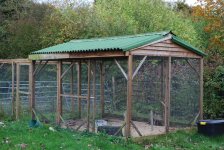cluckingcrazy
New member
- Joined
- Oct 23, 2017
- Messages
- 3
- Reaction score
- 0
Hi everyone,
Firstly thanks for letting me in! Hoping i can tap in to the wealth of knowledge.
I need to build a chicken run because theres 8 birds coming soon. Ive gone over and over different plans ideas etc and struggling to pin something down. Ill start by listing what i do know!
Needs a minimum of 80sq ft. Sorry for doing this but thats 2.4m (8ft) x 3.0m (10ft) and works pretty well with timber cutting.
Entire run will be covered in clear corrugated roofing.
1" welded wire mesh. Might put a finer layer around the bottom ft or so.
My thinking has been either frame up 3 x 2s and sit it on the ground. Or use 4x4's at the corners, concreted, all connected with 3x2s. Im trying my best to scrimp and save with build costs but obviously dont want to go to extreme and compromise standard. The area its in is sheltered from wind but nothing with rain and the whole garden gets quite boggy. Im planning on digging a 1ft trench around the run back filled with pea gravel, hoping this with a covered run should allow it to not get too boggy and let it dry out. Some of the ebay frames ive seen look quite thin and if theyre selling them i cant help but think my plans should be substantial enough but i cant work out loads etc.
Any help or advice? Bearing in mind im money and time restricted.
My fall back plan is to get one of the 3m x 3m dog runs off ebay and wrap the lower layers in finer mesh.
Thank you for taking the time to read.
Firstly thanks for letting me in! Hoping i can tap in to the wealth of knowledge.
I need to build a chicken run because theres 8 birds coming soon. Ive gone over and over different plans ideas etc and struggling to pin something down. Ill start by listing what i do know!
Needs a minimum of 80sq ft. Sorry for doing this but thats 2.4m (8ft) x 3.0m (10ft) and works pretty well with timber cutting.
Entire run will be covered in clear corrugated roofing.
1" welded wire mesh. Might put a finer layer around the bottom ft or so.
My thinking has been either frame up 3 x 2s and sit it on the ground. Or use 4x4's at the corners, concreted, all connected with 3x2s. Im trying my best to scrimp and save with build costs but obviously dont want to go to extreme and compromise standard. The area its in is sheltered from wind but nothing with rain and the whole garden gets quite boggy. Im planning on digging a 1ft trench around the run back filled with pea gravel, hoping this with a covered run should allow it to not get too boggy and let it dry out. Some of the ebay frames ive seen look quite thin and if theyre selling them i cant help but think my plans should be substantial enough but i cant work out loads etc.
Any help or advice? Bearing in mind im money and time restricted.
My fall back plan is to get one of the 3m x 3m dog runs off ebay and wrap the lower layers in finer mesh.
Thank you for taking the time to read.


